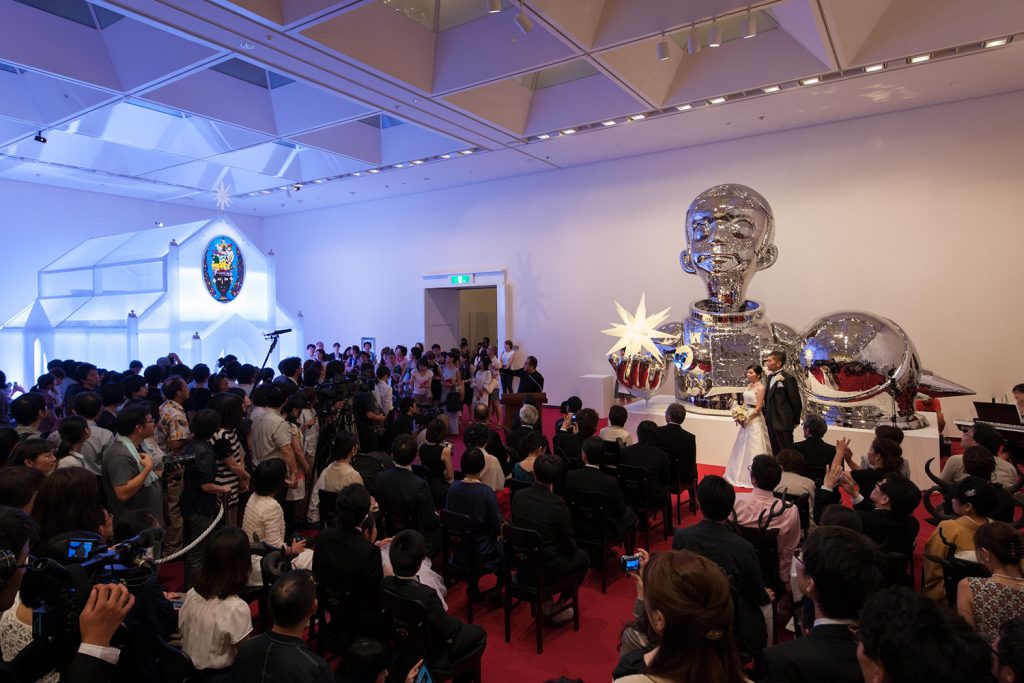Wedding Ceremony of the Sun [2013]
The Revival of Love and Beauty
Aichi Triennale 2013, the second one following 2010, was held with the theme Awakening–Where Are We Standing?–Earth, Memory and Resurrection. The theme clearly contained a fundamental question:“What can art do in our society after the Great East Japan Earthquake?”
Kenji Yanobe was invited to join the Triennale and Sun Child (2011-2012) was chosen as the main image. The plan Yanobe proposed was Wedding Ceremony of the Sun (2013), a project to hold wedding ceremonies at Aichi Prefectural Museum of Art (APMOA), where he was asked to exhibit his works.
After he made Sun Child, he was planning a project Temple of the Sun/Sun Child Island (2011). For the site of the temple, he was supposing hill of Aso in Kumamoto Prefecture. There is a manmade lake and he was planning to build a cathedral underground of an island in the lake. The island is compared to Mont Saint-Michel, and the lake is separated into two halves like Crossing the Red Sea, and couples enter the cathedral to have wedding ceremonies.
In the cathedral, he is planning to install his works such as Sun Child made of marble, Queen Mamma (2002), a collaborative work with Issey Miyake, Lucky Dragon Concept Maquette (2009) and Phantasmagoria (2007). The cathedral is meant to be a wedding hall in the style of museum.
For the Aichi Triennale 2013, Yanobe gathered his works and concept models to partially realize Temple of the Sun. As new works, he made Ultra Sun Child (2013) with stainless steel and Church Chair (2013) with the relief of animals, Sun Child(Stained Glass) (2012). He also made The Chapel of the Sun (2013), a small chapel with the stained glass based on the drawing by Beat Takeshi. He composed an installation work Wedding of the Sun.
For this project, he selected Florilege des lamours de Ronsard (1948) works of lithograph by Henri Matisse from the museum’s collection. He installed them in the chapel to imply the process how Matisse made his monumental work, Chapelle du Rosaire (1948-1951).
As compared with Temple of the Sun, which is conceived as a wedding hall in the style of museum, Wedding Ceremony of the Sun is a project to turn the museum itself into a wedding hall. It is also meant that the visitors to the museum “understand” the origin of beauty through “love”(wedding ceremony)”. In Japanese, Aichi is written as 愛知, 愛 means “love” and 知 means “understand”. The concept is also related with the name of prefecture and the fact that Aichi prefecture has many churches mainly used for wedding ceremony.
Temple of the Sun is also an attempt to make a new temple of sun, which would replace nuclear power plants, the temples of sun created by modern technology and have brought about critical faults. Wedding Ceremony of the Sun is an attempt to going upstream to the origin of god, love and beauty, which are separated in modern civilization and try to unite, “marry” them again.
In the project, the actual couples had wedding ceremonies there and the museum as a wedding hall was full of festivity. The project revived the relationship between love and beauty in a good way. Through this project, Yanobe embarked to show his ideas on art and museums in 21st century. His attempt left a big impression on the visitors and guests of the wedding ceremonies. Beyond the framework of art project, Wedding Ceremony of the Sun was also a ceremony to revive the human spirit.
